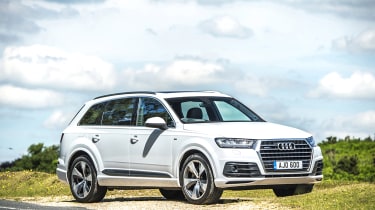Audi Q7 review - lighter and more efficient but anymore fun to drive?
Better to drive and plenty of tech, but still behind rivals
This is Audi’s second generation Q7, the follow up to the original that has sold over 510,000 units since its introduction nearly a decade ago.
Distinguishable from the original by its new Audi corporate nose job, the new Q7 has had more than a quick nip and tuck, with the Inglostadt engineers going to town on reducing the car’s weight, improving its efficiency and raising its appeal.
At launch it’s offered with just one engine option in two states of tune – the 267bhp as tested here, and the entry level 215bhp model – and in two trim lines: SE (£50,340) and S Line (£53,835). An eight-speed automatic gearbox is the only transmission option and permanent four-wheel drive is standard.
Competing with BMW’s X5, Range Rover’s Sport, Mercedes GLE, Volvo’s new XC90 and Porsche’s Cayenne for the premium SUV customer the Q7 majors on interior comfort, space and technology, the former involving a third row of seats.
Technical Highlights
Saving weight was a big priority for Audi with the new Q7 and overall a substantial 325kg has been trimmed from the outgoing model – the base Q7 weighs 1995kg. The body in white is 75kg lighter, the aluminium doors are 24kg lighter and the front and rear five-link suspension saves a further 67kg.
More reviews
Other technical highlights included optional four-wheel steering. Not to dissimilar to the system fitted to Porsche’s 911, the four-wheel steering technology shortens the wheelbase at low speeds by allowing the rear wheels to steer in the opposite direction to the front wheels, while at high speed the rear wheels steer in the same direction as the fronts to ‘increase’ the wheelbase length and improve high-speed stability. Air suspension is also an option on all Q7 models.
Audi’s Virtual Cockpit appears in the Q7 for the first time accompanied by the company’s latest MMI infotainment system featuring Apple Car Play and Google Android Auto.
What’s it like to drive?
If you’ve driven an original Audi Q7 you’ll be aware of its shortcomings from behind the wheel, notably that it found it impossible to hide its size and weight, and that you didn’t so much as drive it as captain it along your chosen course; Preferably a wide course with no obstacles and few bends.
It may be stretching it to suggest the new Q7 is an out and out dynamic wonder, but that weight loss has gone a long way to improve the experience from behind the wheel.
The front end now responds quicker with heightened alertness to steering inputs, and the body, with cars fitted with air suspension, is far better controlled at dealing with both undulations and directional changes, remaining settled and composed.
The powertrain, and at least in 267bhp state of tune is well suited to the task in hand, and with the weight loss the Q7 has some get up and go. 62mph arrives in 6.5-seconds and it will top 145mph while returning 47.9mpg. The 443lb ft of torque delivered at 1500rpm goes a long way to making the Q7 quicker than Porsche’s entry level Cayenne Diesel.
Overall, what the Q7 sacrifices in dynamic ability and driver interaction it makes up for in usability, practicality and being refined, quiet and a relaxing place to be to cover big distances with big load on board. It’s not exactly evo, but the Q7 delivers in the areas where it needs to and is expected of it, and for that it’s hard to criticise.
Rivals
Porsche’s Cayenne still has the edge dynamically, but it’s showing its age against BMW’s latest X5, which can also be had with a third row of seats. Mercedes new GLE matches the Q7 for quality and a sense of occasion and Range Rover’s Sport certainly has the kerb side appeal many in this sector crave, leaving the Q7 to live somewhere in the middle of the pack.



